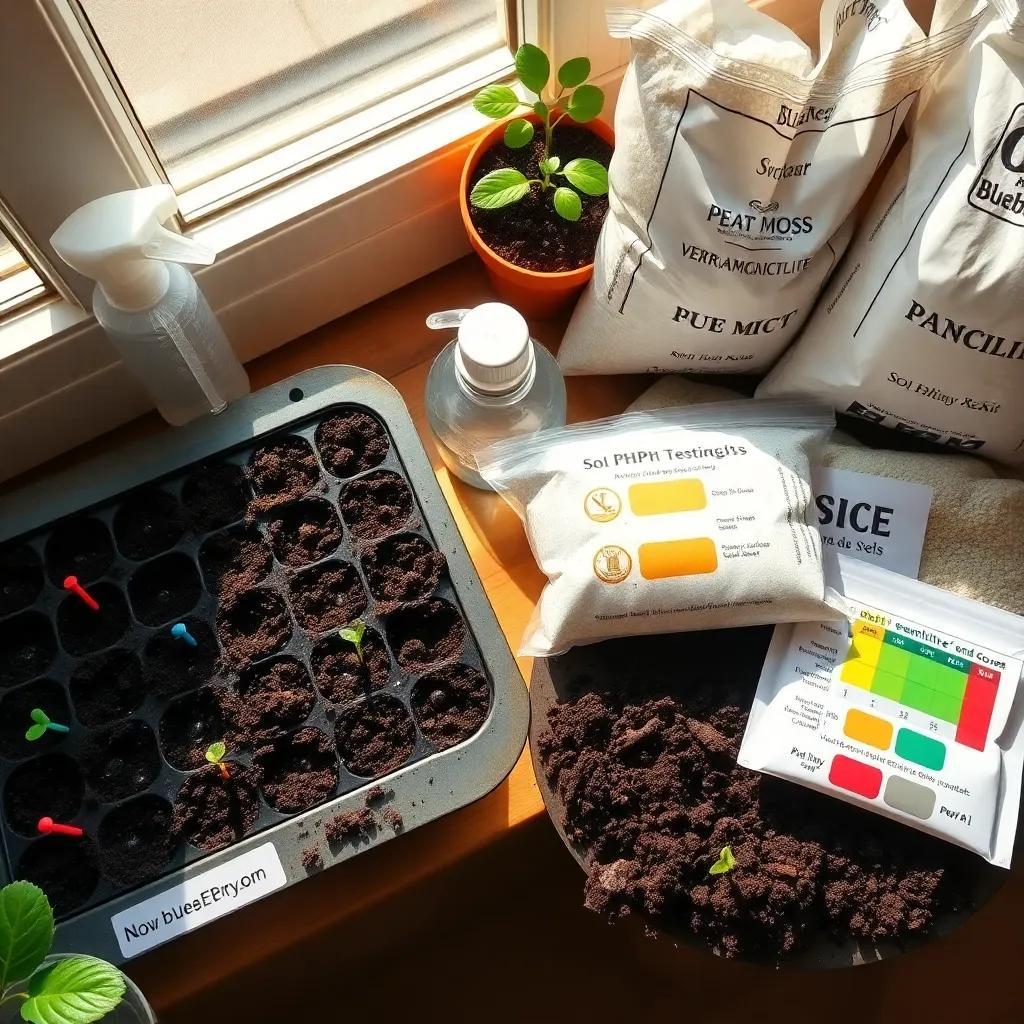Are you ready to dive into the wonderful world of growing blueberries from seeds? I can’t wait to share my journey with you! From setting the perfect temperature to overcoming pesky challenges, this guide will help you succeed in growing your very own berry-filled paradise. Let’s get started on this delicious adventure together!
Ideal Temperature and Moisture for Blueberry Germination
Getting the temperature and moisture just right is like finding the perfect recipe for blueberry pie—it’s key! Blueberry seeds are a bit picky, preferring a cozy temperature that ranges from 60 to 70 degrees Fahrenheit (15 to 21 degrees Celsius). It’s like they want a sweet spot, not too hot and not too cold! If the environment is too warm, the seeds might just sulk and refuse to germinate. And we don’t want that!
Now, let’s talk about moisture. Blueberry seeds crave a moist growing medium. This means keeping the soil damp but not like a soggy sponge! The goal is to have a happy balance. Think of it this way:
- Too much water can cause the seeds to rot. Nobody wants that!
- Too little water could tell the seeds to take a nap instead of sprouting.
So, how do you keep things just right? Here are my tips:
- Check the soil regularly: Use your finger to feel the soil. If it’s dry about an inch down, it’s time for a little water.
- Mist the soil gently: A spray bottle works wonders to keep things moist without drowning them!
- Use a humidity dome: If you’re feeling fancy, a little greenhouse effect can help maintain moisture and warmth.
If you follow these guidelines, your blueberry seeds will have the best chance to sprout and grow into delightful plants! Don’t forget to keep an eye on the temperature and moisture levels. Happy growing!
Essential Soil Composition for Growing Blueberries
Now that we’ve got the temperature and moisture down, let’s chat about the secret ingredient for happy blueberry seeds: the soil! Blueberries are like prima donna plants; they love acidic soil with a pH range of 4.5 to 5.5. That’s right, they need the right soil conditions to thrive and produce those juicy fruits we all love!
What’s the magic formula for creating this perfect soil? It’s easier than you might think! Here’s a simple mix you can create:
- Peat moss: This is like the base of our soil cake! It helps maintain moisture and adds important nutrients.
- Vermiculite: This fluffy friend improves aeration and helps the soil retain moisture without getting soggy.
- Perlite: This little miracle helps with drainage. Nobody likes waterlogged roots!
Mix these components together, and you’ve got a winning combination! But don’t just stop there. Testing your soil pH is key. You can find simple soil test kits at garden centers. If your soil is too alkaline, no worries—add some organic matter like pine needles or sulfur to lower the pH.
Remember, blueberries are picky eaters, so avoid regular garden soil that might be too alkaline for their taste. Creating the right soil conditions is like giving your seeds a cozy hug, helping them thrive and grow into the beautiful plants we all adore!
So go ahead, mix that soil, and watch your blueberry adventure take off!

Techniques for Preparing Blueberry Seeds
Getting your blueberry seeds ready to sprout is like prepping for a fun baking day—there are a few key steps to follow! Here are some techniques I swear by to kickstart the germination process.
1. Seed Scarification
Blueberry seeds have a tough outer coat. This can be a little stubborn when it comes to soaking up water. A little trick I’ve learned is scarifying the seeds! You can do this by lightly rubbing them with sandpaper or a nail file. Just a few scratches can help them drink up that moisture like they’re at a spa!
2. Cold Stratification
Some blueberry types really appreciate a cold treatment. This simulates winter and wakes them up from dormancy! Here’s how to do it:
- Place the seeds in a damp paper towel or a slightly moist medium.
- Pop them in the refrigerator for about 4 to 6 weeks.
This chilly period is like a refreshing nap for the seeds before they get to sprout!
3. Pre-soaking
Want to boost those water absorption skills? Pre-soaking is a fantastic method! Just soak your seeds in warm water for a few hours or overnight. Some folks even add a splash of hydrogen peroxide to kick out any pesky fungi.
4. Germination Test
Feeling uncertain about your seeds? You can give them a quick germination test! Take a couple of seeds and place them between damp paper towels in a warm area. Check back in a week or two—if they sprout, you’re golden!
By following these tips, you’ll set your blueberry seeds up for success. It’s like giving them a head start in the race of life!
Common Challenges in Germinating Blueberry Seeds
Even with all the excitement of germinating blueberry seeds, it’s not always a walk in the park. Just like in any recipe, there might be a few hiccups along the way! Let’s explore some common challenges and how to tackle them.
1. Low Germination Rates
Ever planted seeds only to find that hardly any sprouted? Ugh, right? This can happen with blueberry seeds. They can be a bit unpredictable. To give yourself a better shot, plant more seeds than you need—this way, even if some don’t germinate, you’ll still have enough plants!
2. Slow Germination
Ah, the waiting game! Blueberry seeds can take 4 to 8 weeks or even longer to sprout. It makes me want to tap my fingers impatiently! Keep the environment cozy and moist, and don’t forget to check regularly. Sometimes patience really is a virtue!
3. Fungal Diseases
Too much moisture can lead to fungal issues like damping-off. Yikes! To avoid this, make sure your soil drains well and that your seeds get adequate air circulation. A gentle breeze from a small fan can work wonders—just don’t place them in a drafty spot!
4. Improper Soil Conditions
If the soil isn’t right, it can affect how your seeds do. Remember, blueberries love acidic soil! Test your soil first. If it’s too alkaline, make adjustments using organic amendments to bring down the pH.
By staying alert and knowing what to watch out for, you can nip these challenges in the bud (pun intended!) and enjoy a successful seed-germination adventure!
Timeframe for Seed Germination and Growth
Now that you’ve got all those seeds ready and addressed potential challenges, let’s talk about what happens after the seeds start waking up. Understanding the timeframe for blueberry seed germination can help you plan everything just right!
Germination Period
Blueberry seeds are not sprinters; they are more like slow and steady turtles. On average, they can take anywhere from 30 to 90 days to fully germinate. Yes, you read that right—patience is key! Some may sprout sooner, while others might take their sweet time.
Factors Influencing Growth
The timeframe can be influenced by several factors, including:
- Temperature: Keeping that cozy 60 to 70 degrees Fahrenheit range is important.
- Moisture Levels: Consistent moisture helps speed things along but remember not to overdo it!
- Seed Quality: Fresh, healthy seeds are more likely to sprout quickly.
Post-Germination Care
Once those little green sprouts appear, it’s time to show them some love! Carefully transplant them into individual pots. Keep providing the right care with adequate sunlight, water, and nutrients.
And here’s the fun part: after around 2 to 3 years, your blueberry plants will start giving you delicious, juicy berries! It’s like waiting for a surprise party—you get so much joy when the time finally comes!
So mark your calendars, keep your fingers crossed, and let the blueberry-growing adventure continue! You’re one step closer to enjoying the fruits of your labor!

